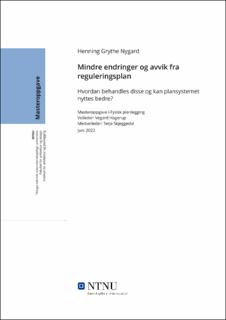| dc.description.abstract | Oppgaven belyser og drøfter bruken av «mindre endring» av reguleringsplan etter plan- og bygningsloven (PBL) § 12-14 i forhold til «full reguleringsendring» og dispensasjon. Dette ut fra lovgivers intensjon om enklere og raskere endring av plan og mindre bruk av dispensasjon. Solbergregjeringen hadde som mål å få til en enklere og raskere plan- og byggesaksbehandling, og alt tyder på at dagens regjering ønsker det samme. Et spørsmål er da om dette kan gjøres som «mindre endring», «full reguleringsendring» eller som dispensasjon. På grunnlag av bakgrunn for oppgaven vil problemstillingen bli: i hvilken grad og hvordan nyttes planredskapet «mindre endring», og hvilke fordeler/ulemper har redskapet sammenlignet med dispensasjon og «full reguleringsendring».
Forskningsspørsmål er med på å besvare problemstillingen og belyser temaer rundt omfanget av bruken, argumenter og vurderinger, raskere og mer fleksibel behandling av endringer, forutsigbarhet og medvirkning, samt om det er behov for forbedring av praksis eller lovverket. I oppgaven blir det presentert relevant teori og rammeverk, hvor mye av dette bygger rundt endring og avvik fra plan. Metodene som nyttes er både kvantitative og kvalitative i form av spørreundersøkelse, dybdeintervju og dokumentstudier. Det blir gjort analyse og diskusjon av interessante funn fra resultatdelen, hvor det blant annet blir sett på faktorer til variasjon i bruk, og om bruken av «mindre endring» har går ut over forutsigbarhet og medvirkning.
I slutten av oppgaven vil det bli trukket konklusjoner på bakgrunn av resultater, samt analyse og diskusjon. Funnene indikerer at lovendringen i 2017 av §12-14 i PBL har hatt en effekt, og ført til økt bruk av forenklet behandling av mindre planendringer. Det er ikke gjort funn av at lovendringen i 2017 har vært med på å redusere dispensasjoner i stor grad. Det er stor variasjon blant kommuner om hvor mye planredskapet brukes, og hvilke endringer som gjøres ved bruk av metoden. Kommunenes informasjon/bevisstgjøring, samt planens plassering ser ut til å kunne ha en innvirkning på dette. På bakgrunn av resultater er det ikke antydninger til at bruken av «mindre endring» har gått på bekostning av medvirkning og forutsigbarhet. Slik bør denne åpningen for enklere behandling av mindre endringer av reguleringsplaner brukes i enda større grad enn i dag. | |
| dc.description.abstract | This thesis discusses the use of «minor change» of zoning plan according to Planning and Building Act § 12-14, comparisons are made to dispensation and full change of zoning plan. This is based on legislators’ intention of simpler and faster change of plans, and less use of dispensation. The Solberg government aimed to achieve a simpler and faster planning and construction case processing, and all indications are that the current government wants the same thing. A question then is whether this can be done as a “minor change”, “full change” or as a dispensation. Based on the background of the thesis, the issue becomes: to what extent and how is the planning tool “minor change” used, and what advantages/disadvantages does the tool have compared with dispensation and full change of zoning plan.
Research questions help to answer the issue, and examines topics around the scope of use, arguments and assessments, faster and more flexible processing of changes, predictability, and participation, as well as whether there is a need/opportunity for improvement of the practices and law. The thesis presents relevant theory and framework, where much of this is about change and deviation from plan. Based on the results, there will be made an analysis and discussion part, like various factors of variation in use, and whether the use of "minor change" has affected predictability and participation.
At the end of the thesis, conclusions will be drawn based on results, analysis, and discussion. The results indicate that change in the law in 2017 had had an effect and led to increased use of simplified treatment of minor plan changes. The change in the law in 2017 has not helped to reduce dispensations to a great extent. There is variation among municipalities about how much the planning tool is used, and what changes are being made. Municipalities information and awareness raising, as well as the location of the plan, seems to have an impact on this. Based on the results, there are no indications that the use of "minor change" has been at the expense of participation and predictability. Based on this, the opening for easier processing of minor changes to the zoning plan should be used more than today. | |
